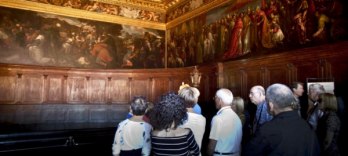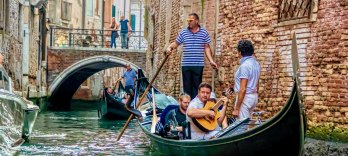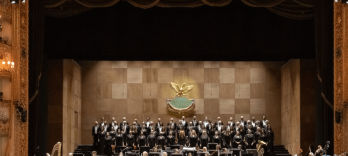La Traviata Opera in Venice
Mo | Tu | We | Th | Fr | Sa | Su |
The mise en scène of La Traviata by Giuseppe Verdi has strong links with Venice: it was first performed at the Gran Teatro La Fenice on March 6th 1853. Musica a Palazzo adheres to the “indications for contemporaneity” requested by Verdi for the first performance (which caused a scandal due to its brazen realism).
The first act begins in the Portego (central hall) and the spectators will realise with amazement that they are actually playing the role of the Violetta’s guests (Traviata): she drinks a toast with them and among these she will meet Alfredo.
The second act is staged in the Sala Tiepolo, the beauty and privacy are the perfect setting in which to appreciate the subtlety of the character’s “inner speech” and to be moved by her vicissitudes.
The drama of Violetta’s illness and death takes place in the bedroom with an alcove where not even the extraordinary beauty of the 18th-century stuccoes are able to distract the spectator from the emotional intensity of the song: the voices of the performers that are so intimately close, will tug at your heart strings.
Program and cast
WHEN
Every Monday, Tuesday, Thursday and Saturday
DURATION
Approximately 2 hours, including the interval. The Palace opens to the public at 8 pm, the performance starts at 8.30 pm.
INTERVAL
During the interval, in the halls overlooking the Grand Canal, our guests will be free to taste top quality wines and soft drinks.
PERFORMANCE LANGUAGE
Italian, no subtitles
Palazzo Barbarigo Minotto
Musica a Palazzo offers a new way of experiencing the grand Opera
The Opera is a travelling show and each act is set in a different hall of one of the most fascinating Venetian palaces: Palazzo Barbarigo Minotto.
THE ASSOCIATION DIMENSIONE LIRICA
Dimensione Lirica is a cultural association founded in 2009, and since 2020 assumed Musica a Palazzo format in order to make Palazzo Barbarigo Minotto a place where to meet, experiment and to gather in order to spread and broaden the knowledge of Opera culture.
This is how the Musica a Palazzo ensemble conceives the ‘Chamber Opera’: the traditional setting of Opera in the theatre is replaced by a stage that fits in perfectly with the scenery: every act of the opera takes place in a different hall of the palace, the magnificent baroque furnishings of which are a natural complement to the set design.
The originality of the direction is represented by the interaction between the singers, the instrumentalists and the audience, breaking down any kind of barrier between them, giving the viewer the thrill of experiencing the Opera from within.
This feeling is enhanced by the skilful use of all-round stage space.
Following a tour throughout the United States, Musica a Palazzo, has staged La Traviata for the 41th international Brighton Festival (UK) held at the Royal Pavilion, where it has proved to be a huge success with both the audience and the critics, by winning the Press Award (The Argus Angel Award) as the best production of the Festival. Recently it has also staged The Barber of Seville at the Potsdam Music Festival in Germany.
Location
Palazzo Barbarigo Minotto
Overlooking the Grand Canal, historical evidence proves that the construction of this noble Venetian palace dates back to around the 15th century.
It consists of three halls facing the Grand Canal and just as many on the Rio Zaguri; during the first half of the 18th century, this palace was embellished by the work of artists whose fame and talent are still acknowledged today.
The painters Giambattista Tiepolo, Francesco Fontebasso, Jerome Mingozzi and the stucco worker Carpoforo Mazzetti, also known as Tencalla were commissioned by nobleman Pietro Barbarigo, the works of whom are perfectly preserved and are still appreciated by scholars and art lovers.
The palace houses a 17th century aristocratic family chapel, with Louis XIV style elm flooring, inlaid with olive and other fine wood. The doors are also in the Louis XIV style with walnut wood panels and decorated with vine leaf-shaped bronze handles, while the flooring is a blend of terrazzo, Venetian “pastellone” pavings.
For further information on the history of Palazzo Barbarigo Minotto, please visit the page on Wikipedia Musica_a_Palazzo
Articles of association
In order to attend any activity of the association, including evening performances, it is necessary to be officially registered as a member. After filling out the application form, the new member will be given a membership card.
Following this link, you can read or download the articles of association which regulate Musica a Palazzo activities.
Donations
The association does not receive any public funding or sponsorship. Every year, Dimensione Lirica dedicates itself to the restoration and maintenance of the main floor in Palazzo Barbarigo Minotto, the costs of which are very high in a city like Venice.
Therefore, we will be extremely grateful to those who wish to make contributions to support the association.
More about the venue/theater:
The Palazzo Barbarigo Minotto (also called Palazzo Minotto Barbarigo) is a 15th-century palace on the Grand Canal in Venice, northern Italy, next to the much larger Palazzo Corner.[1] Built in the Venetian Gothic style, it was originally two palaces, Palazzo Barbarigo and Palazzo Minotto, later joined together. The Barbarigo palace was owned by the Barbarigo family for several centuries and was the birthplace of Gregorio Barbarigo, who once refused the Papal Crown.[2] It was later owned by the Minotto and Martinengo families.
The facade of Palazzo Barbarigo-Minotto on the Grand Canal of Venice.
Three staterooms face the Grand Canal and another three face Rio Zaguri. In the first half of the 18th century frescoes and paintings by Giovanni Battista Tiepolo, Francesco Fontebasso and Carpoforo Tencalla were commissioned by Pietro Barbarigo. Its chapel has Louis XIV Style elm flooring inlaid with olive-root marquetry. The palace's doors, are in the same style, banded in walnut with bronze handles shaped as vine leaves. The floors of the staterooms are a blend of terrazzo paving and Venetian "pastellone" paving.
The palace is actually formed by two different buildings, merged in the 17th century. The ancient part, a 1400s Venetian-Gothic architecture featuring 12th century Byzantine friezes, was originally known as Palazzo Minotto; the newer part, Palazzo Barbarigo, was built in the 17th century.
Performances: Mo 20 May 2024,
Performances: Tu 21 May 2024,
Performances: Mo 20 May 2024,
Performances: Mo 20 May 2024,
Performances: Fr 31 May 2024,
Performances: Sa 28 Sep 2024,

 EN
EN DE
DE IT
IT FR
FR ES
ES RU
RU JP
JP RO
RO





